
Tips for Buying & Making Preemie Clothes
How to Help Parents of Preemies
ARCHIVES:
Eating & Reflux (year 2, 2006)
Allergies & Getting Big (2009)

On July 4, 2005, my water broke. I was just 20 weeks pregnant. Our
doctors predicted our daughter would die at birth, but after a great
deal of prayer (which many readers of this blog participated in),
Anastasia (“one who will rise again") turned into a miracle. Later, we
were blessed with a baby boy, though we struggled to keep him inside the
womb for as long as possible.
Here is the quick version of our story. Please go back through this
site's archives for complete details of all of ours struggles and
triumphs.
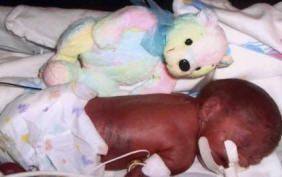

From left to right: Anastasia at birth; on her first birthday; on her second birthday. The same Beanie Baby bear is in every photo.
THE FIRST PREGNANCY
At barely 20 weeks into my first pregnancy, I went to the emergency room
with what felt like mild contractions. My doctor examined me and said
everything looked fine; what I was feeling, he said, might just be gas.
However, the following evening I had a headache; I sat down to watch a
DVD with my husband, but when I got up from the couch at the end of the
movie, liquid gushed out of me. I'd read that amniotic fluid
smells like the cleaner Comet, but this liquid had no smell at all. I
wondered if maybe I had some sort of infection.
After a sleepless night (where the liquid kept pouring from me), I
called my doctor and met him in the emergency room. He tested the fluid,
but the test was inconclusive. He also looked at the fluid under a
microscope, watching for the so called "ferning" that typifies amniotic
fluid. The fluid did not fern. (I later learned amniotic fluid often
does not fern when it's tested so early in a pregnancy.) Finally, my
doctor did an ultrasound. Even I could see the amniotic fluid around our
baby was extremely low. I was sent home and told to stay on bed rest
until I could consult with a high-risk pregnancy specialist (called a
perintologist). I had experienced
PROM, or Premature Rupture of the Membranes.
The day my husband and I went to the perintologist felt like the worst
day of my life. The specialist had nothing positive to say. He explained
how important amniotic fluid is to the baby at this stage, and told me
our daughter would probably not be able to breathe at birth. He also
said that if she somehow managed to breathe, she'd likely have bone
malformations, because there was virtually no amniotic fluid to protect
her from being crushed by my organs. In addition, he said she was
extremely high risk for cerebral palsy, blindness, and a host of other
medical issues. My husband and I were in utter shock.
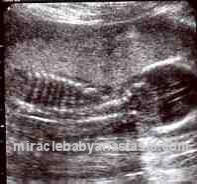
One of Anastasia's post-PROM ultrasounds.
The specialist advised me to "terminate the pregnancy," which I refused
to do. (Despite my unhesitating reply, throughout the remainder of my
pregnancy, he asked me twice more to abort our child. Each time, I
refused.)
The perintologist then told me I'd probably miscarry within two weeks.
With that, he sent me home for more
bed rest,
and told me to look for signs of infection.
Anastasia didn't miscarry (the stubborn girl!), and I did not develop an
infection, so the plan was to admit me into the hospital at the
beginning of my 25th week, if Anastasia made it that far. At this time,
I'd be on hospital bed rest, and would get steroid shots to help
Anastasia's lungs develop. When I questioned why I couldn't do all this
sooner rather than later, nobody gave me a straight forward answer,
other than to say the baby wasn't "viable" until 25 weeks or so. This
was upsetting, but the fact that Anastasia hadn't miscarried in two
weeks gave me some confidence. I was going to carry this baby at least
until 25 weeks, I decided. (I later discovered that babies as early as
22 weeks can survive outside the womb.)
ANASTASIA'S BIRTH STORY
When the end of week 24 arrived, I once again felt contractions. When I
called my doctor, he sounded glum and said, "Well, at this stage, I
don't think we'd attempt any heroics - no C-section." I mentioned
contraction-reducing drugs, and he said yes we could use those - but
they rarely work well for a woman whose water has already broken.
Once I got to the emergency room that night, the contractions subsided.
Since I was scheduled to check into the hospital the following day, my
doctor decided to admit me that evening instead.

Anastasia's at birth.
The following day I had one steroid shot. The next day I had another.
And so I settled in for what I thought would be a somewhat long stay in
the hospital. At this point, the doctors said that if Anastasia was born
soon, her chances for survival were 30%.
The day after the nurses told me the steroid shots had done all the good
they were going to do, I started having contractions again. They came
and went, but eventually became pretty strong. My doctor prescribed a
contraction-reducing medicine. This worked well for a day - until I got
up to take a shower. Then the contractions started again. Soon I was in
real pain.
My obstetrician came to the hospital at about 5:20 pm, and preparations
began for Anastasia's delivery. The doctor did an ultrasound to see if
Anastasia was breech; she was. He did a physical exam to see if I was
dilated; I was not. I told him I wanted a C-section, because I felt it
would give Anastasia the greatest chance of survival. He didn't like the
idea of doing this (because of what it would mean for future
pregnancies), but he consulted my perintologist, who said he should go
ahead with a C-section, just so that I'd feel everything possible had
been done to save Anastasia. I believe they fully expected her to die.
At 5:57 pm, my doctor pulled Anastasia out of me and handed her to
a neonatologist (a doctor who specializes in treating preemies). He
stuck a tube down Anastasia's throat and tried to resuscitate her. A
nurse later told me they had difficulties getting oxygen into
Anastasia's lungs, and felt sure this baby was not going to make it. But
the doctors were (once again!) wrong. Anastasia was resuscitated. She
weighed 1 lb. 13 oz. and had no malformations. She was born at exactly
25 weeks and 2 days.
HOSPITAL STAY
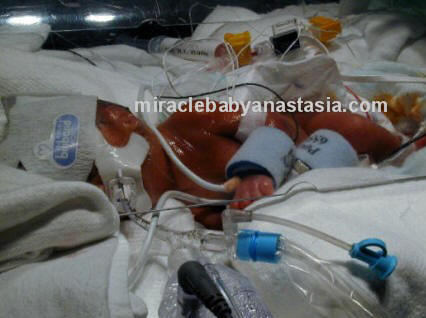
In the NICU.
Initially, Anastasia was in a private room, hooked up to a ventilator
that did all her breathing. The pressure of the oxygen being pushed into
her made one of her lungs pop. She had emergency surgery to prevent air
from escaping through the resulting hole. Anastasia was also diagnosed
with chronic lung disease (or BPD) and PDA (a heart murmur), and was
treated for the latter with medication.
She graduated to a ventilator that only "breathed" when she didn't, and
then started breathing with the help of a CPAP machine. Almost
immediately, she was transferred to a Vapotherm machine, which gave her
less oxygen than the CPAP. We were finally allowed to hold Anastasia on
a fairly regular basis. (Vapotherm machines were recalled shortly after
Anastasia graduated from hers. At this time, they are no longer in use.)
Anastasia was moved to a "public" part of the NICU, and just sailed
along - until she started having a lot of "bradys" (where she stopped
breathing and her heart rate dropped dramatically). She scared the
nurses several times, and had to be "bagged" (oxygen hand-pumped into
her mouth). The neonatologist tested her for infection, and it came back
positive for Staph.
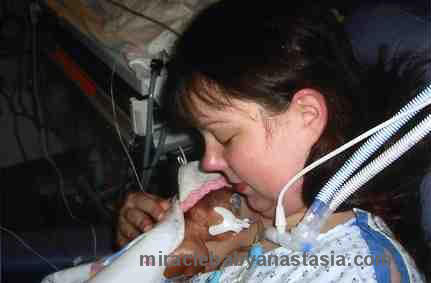
The first time I held Anastasia.
So she went back on the ventilator and was treated with antibiotics.
About ten days later, she quit the medication, and was back to her usual
self.
Then we waited while she outgrew
apnea of
prematurity (periods of "forgetting" to breathe) and learned to suck
milk. We had to wait a long time for both. It wasn't until she was one
month past her due date that she was able to breathe without oxygen (a
miracle in and of itself, as the doctors felt she'd need it for many
more months to come). She never learned to breastfeed, and she relied on
a
NG tube (which ran from her stomach to her nose) for her food until
almost the day she came home.
She also had an
ROP scare, where the eye doctor felt she might need laser eye
surgery or she'd go blind. But just before he made his final decision,
the ROP cleared up on its own. Her PDA resolved itself, too.
Anastasia spent 133 long days in the NICU and came home at about 11 lbs,
wearing an apnea monitor.
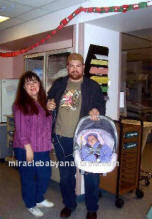
Coming home - just in time for Christmas.
HOME AT LAST
Upon coming home, Anastasia's main hurdles were to avoid
RSV (a virus that
preemies are especially susceptible to, and which would, at the very
least, send her back to the hospital), to catch up developmentally, and
to eat.
The first problem we battled by being vigilant about hand washing and
avoiding public places. Anastasia also received some very painful
vaccinations during RSV season (which is generally from October through
May).
Developmentally, Anastasia has always been behind in her
gross motor skills. At 14 months
corrected age (17 months chronological age), Anastasia learned to
crawl, pull up, and stand momentarily without assistance. At 20 months,
she cruised and stood up alone. At 21 months, she learned to walk
without assistance. To help her along, she saw a physical therapist
every other week, and we did therapy exercises with her at home.
Anastasia was also diagnosed with very mild
torticollis (which, after
physical therapy, disappeared) and possibly a sort of muscle weakness
called ataxia,
although that's debatable.
For a long time, Anastasia didn't eat as much as the doctors thought she
should, but she's made leaps and bounds in this area. Part of her
problem with eating may have been related to
reflux, which we treated primarily
with Prevacid. The remainder of her eating problems seem to stem from
having a tube down her throat for so long; she gags easily, and has
issues with textured foods.

Anastasia in 2011.
Today, Anastasia is a healthy little girl. She is considered "caught up"
developmentally, although we notice she is slightly behind her peers
when it comes to gross motor function. Eating and drinking enough fluids
are not her strengths, but she is not underweight. She also often has
trouble getting enough sleep; this could be related to her prematurity,
but it could also be in her genes. She is also very bright, smart, and
exuberant - and we can unequivocally say Anastasia has no major side
effects from being born 3 1/2 months early.
Click here to watch a video montage of Anastasia's first two years.
Click here to watch a video montage of Anastasia's first two years.
Our Anastasia has come a long, long way, proving repeatedly that doctors
are often wrong. Even the most doom-and-gloom doctors who've treated her
now smile and call her "the miracle baby." She is our miracle,
and a wonderful testament to the love and faithfulness of God.
AND BROTHER, TOO
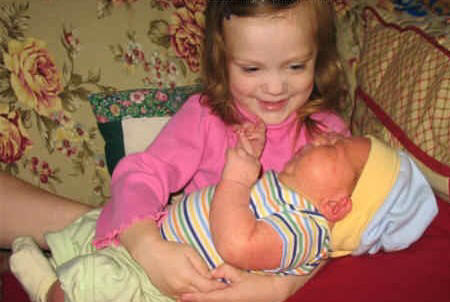
Anastasia holding her baby brother.
In early 2008, we finally decided to try for a second child. For a long
time, we struggled with the fear I'd experience PROM (or worse!) during
another pregnancy. No one knew why my water broke early with Anastasia,
but the doctors said there was a 30 percent chance of it happening
again. Ultimately, we recognized
God doesn't give us a spirit of fear. We were willing to trust him
with another pregnancy.
After consulting with my doctor after becoming pregnant, we followed a
certain set of
guidelines to potentially reduce my risk of experiencing PROM again.
This included less exercise, taking progesterone, and consuming
probiotics. Happily, I did not experience PROM with my second pregnancy.
However, I did develop
gestational diabetes, which I controlled with a very low carb diet
and medication.
On October 17, 2008, I gave birth to a healthy, full term son, whom we
named Zane ("God's precious gift").
Truly, we are blessed.
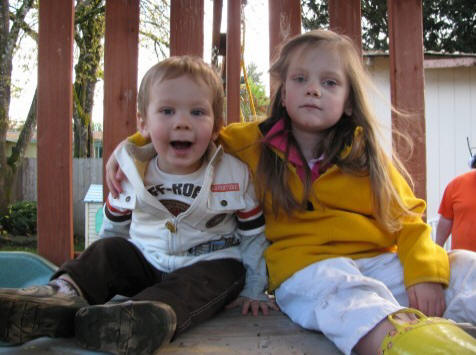
Zane and Anastasia in 2010.
Last updated: October 17, 2011.
"Miracles are a retelling in small letters of the very same story
which is written across the whole world in letters
too large for some of us to see."
C. S. Lewis
This website and all its contents are copyrighted. All Rights
Reserved. No portion of this website may be reproduced without written
permission from the copyright holder.